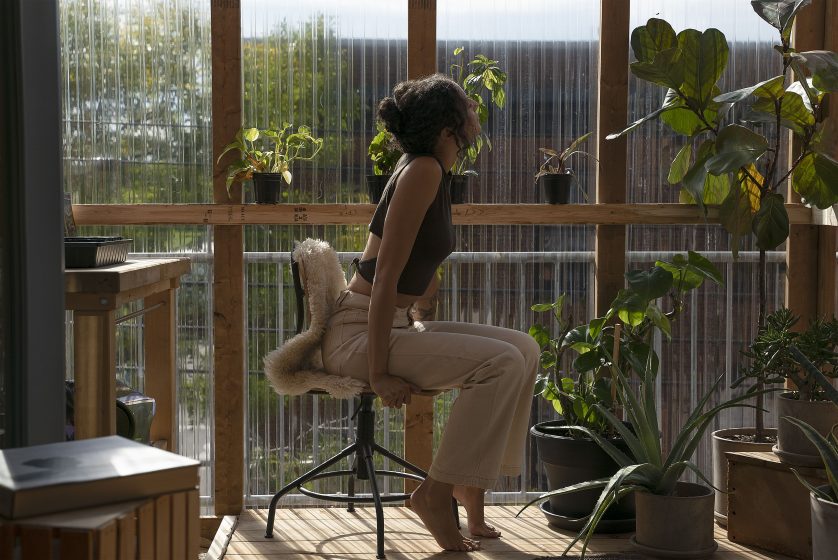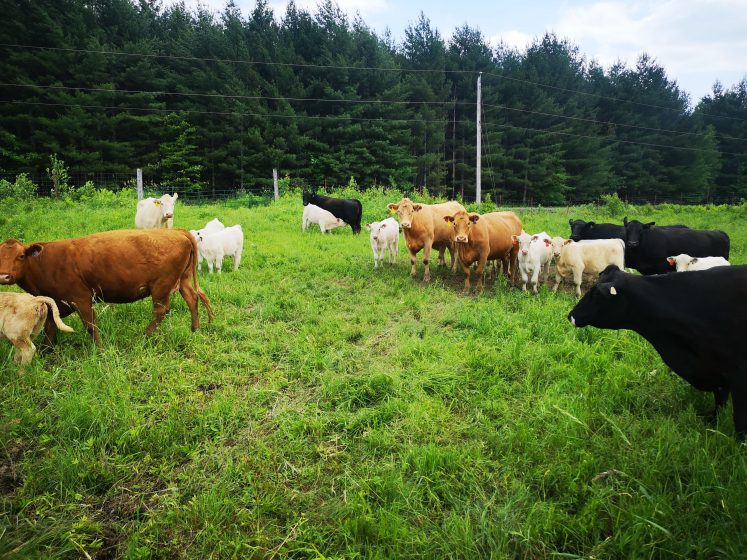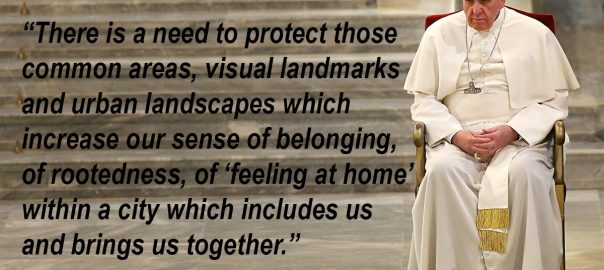Urban building codes and design standards play a crucial role in how a city adapts to contemporary challenges, like climate change and urbanization. I live in Montréal where, like many cities in the world, building codes largely came into force on account of two big urban phenomena: fire and disease. In Montreal’s case, fire was of particular concern. In fact, our building codes are largely responsible for the presence of the iconic outdoor staircases typical of Montreal architecture. They’re everywhere … “Winding ones, wooden ones, rusty and risky ones” … as famous author Mordecai Richler once wrote in The Apprenticeship of Duddy Kravitz.

I’ve been thinking about building codes because I recently had a run-in with them. For quite a few years I’ve been wanting a balcony greenhouse to grow food, protect my houseplants, and gain some reprieve from Montréal’s six-month-long winters. So, one weekend I gathered a couple of people and finally built one. It was spectacular. All of my plants were immediately happier. With near full sun on most days from my south-facing balcony doors, I could see clearly just how a full four seasons of growing was possible in this 4 x 2 square meter wooden house of light and warmth. As the installation came to a close, and I could feel the new space wrapping in around me, I started to wonder to myself: at this late stage of advanced capitalism, and with dwindling time to adapt and mitigate the effects of our changing climate: why aren’t people building more of these?

Looking out over both sides of my balcony there are rows and rows of other balconies which sit empty for the most part. But, at the same time, I live in a neighborhood where the waitlist for a community garden plot is close to five years long. In fact, just a few years ago to help with this the city finally completed the Woonerf project ― a 1.5-million-dollar investment to build an incredible green Woonerf complete with expanded community gardens. This helped, but it merely put a dent in the 3000+ waitlist with just 30 or so new spaces. And, at this scale and expense, it is unlikely that we will see more garden plot expansion anytime soon.
Well, the answer to my question was delivered to my inbox in the shape of one angry landlord who promptly told me to take it down citing: building code violations. I did check, and honestly, there is nothing in there that says I can’t, but it doesn’t say that I can either. So, herein lies the problem, and one that catapulted me into a world of thoughts leading me to conclude: cities need to allow this. Re-visiting and changing building codes to reflect the changing needs of cities ― just like the winding staircases in the age of fire and disease ― is critically important in this case, for two main reasons: One of them has to do with Capitalism and the other with basic human needs: food and wellbeing. Let’s start with the first one.
21st Century Capital is a Vegetarian
You may have noticed this in your city too, but capital investors love green projects. Anywhere there is a plant, garden, green-lane, or the promise of one from the city, these kinds of developers are somewhere lurking in wait for the opportunity of a lifetime: the promise of more profit. Not every developer in a city behaves like this — but far too many of them today do. My neighborhood recently experienced this. In Montréal, I live in a neighborhood called, Saint-Henri. Over the past 15+ years of living here, I’ve fallen in love with the funky edgy undercurrents of the neighborhood. The Saint-Henri – Little Burgundy – Point Saint Charles triangle in the Sud-ouest is historically one of the poorest sectors of the city and is also lovingly remembered as the home and birthplace of quite a few famous jazz musicians, including Oscar Peterson. Last nod: you can also catch a historical glimpse of this part of town’s industrial poverty past as portrayed by the well-known Canadian writer Gabrielle Roy in The Tin Flute.
Over the past 10 years, Saint-Henri underwent a long and slowly drawn-out cadastral surgery where any perceived to be old, run-down, slightly slanted, or otherwise, lot or building ripe for profitable growth was put under the magnifying glass, earmarked by realtors, and targeted by developers for implantation and sale. As beautiful an initiative as the city’s Woonerf project was, it was also unmistakably a driving force for a lot of the mayhem. The city’s investment to revitalize the area sent a signal. A concerted front moved into the neighborhood. We were rebranded as the new “up and coming” place to be in Montréal. Within a short 6 years, the old homes and duplexes that were waiting for gradual baton passing from older generations to slower growing new homeowners and younger families, who would regenerate the cycle and character of the neighborhood, were swooped up to market on the investors’ assembly line. It was impossible to compete with the middleman and the new price tags. A lot of us felt like Saint-Henri had been grabbed, turned upside down, and shaken for any possible pocket change we had. The community organized a housing committee to deal with the onrush of demand for affordable housing, from people who had been displaced.
When I was a student in university, and very much in the abstract, I learned the academic term used for this is called: gentrification. I understood it to mean the rich move in and the poor are pushed out. But, I had yet to live through one. Experiencing it has colored in the nuances. A lot happens before affluence moves in, and it isn’t really the people buying the turned properties you have to worry about — it’s the market signals and the oftentimes unchecked greed of the developers who bought them in the first place. It influences everything from the choice of materials, the speed of construction and design, and the economic class of citizens being catered to and prioritized for marketing and sale purposes. All of these decisions are predominantly dictated by the thought and desire: how much more profit can we make? When the ‘up and coming’ train starts moving, there isn’t much you can do to stop that market force. And annoyingly, there is no centrifugal point, tangible surface, or person to throw stones at. The business of this machine is concluded behind office doors and in paperwork long before you know it’s happening.
It’s impressive, actually. Capitalism is a beautifully clear and simple system that works to motivate and move people “effectively”. I only wish the motivator and end goal was different and that more meaningful driving forces could move as quickly and swiftly as the urge to make profit and power. Unfortunately for us, the leading global economic system is designed around infinite capital growth on a planet that is comprised of finite resources. There is nothing more unabashedly parasitic about the human condition than capitalism. We’re an organism that lives on and drains the resources of many other species to derive benefits and nutrients entirely at the expense of the planet. When I look at gentrification now, I see that giant complex problem in a micro dose, pulsating in my city as one node among many, many, many other incidents of the same thing all around the globe. So, how are balcony greenhouses a potential answer to the failures of giant green urban investment projects?
Firstly, they’re much smaller. They could give more decision-making ability, choice, and access to the citizens ― both renters and owners ― who would be using them according to their needs and context. Changing building codes to allow for this kind of action where citizens and landlords would be allowed, by law and design, to build a balcony greenhouse on existing building stock where feasible, helps make access to nature less scarce and could potentially more justly distribute it. It could provide access more rapidly across the island, by just giving people those tools so we could start to cut into these long waitlists. They could build and choose how they grow. Lastly, you could arguably get more done with the city’s budget if you’re not just concentrating the greening effort on massive, centralized projects. In being smaller, we could afford to incentivize more of them, and the direct benefit of the expenditure is potentially more impactful as a result. Especially for rental stock — it becomes a food asset that stays with the building regardless of the particular renter or owner. Which brings me to the second critical point in support of the balcony greenhouse: food and well-being. In the process of decentralizing greenspace and creating more just urban nature, as a co-benefit we create more space for urban farming and gardening. As the world continues to urbanize and food costs continue to rise as a result of global geopolitical instability, we desperately need to be building infrastructure like this in cities now, for the future.
Food insecurity & urban farming: A marriage proposal
In my city, there is a demand from citizens for more space to garden and farm that is going un-met. At the same time there is growing food insecurity. Food insecurity comes from two things predominantly: a) you can’t afford to buy food, and/or b) food isn’t located close enough to you to access it. After your rent, the second biggest bill is your grocery bill. Saint-Henri is an area of Montreal that has traditionally been food poor. We suffer from both phenomena. Great new places to do your groceries have popped up over the last few years, but people’s access to them remains inequitable. As the neighborhood continues to evolve, more of us are now more affluent, but those new shops are, for the most part, catering to those new affluent neighbors. We are closer to achieving the 15 min city ideal than we ever have been, but 15 minutes for whom? Food is more expensive than ever. St-Henri remains an area where hundreds of people choose between their rent and good quality healthy food each month because they don’t have enough money to do their groceries. And did you know that we are also a neighborhood that wastes food at alarming rates? I volunteer with a community fridge project called Feed the Hen, and I am constantly shocked by just how much free food there is to go around in one tiny neighborhood.

Picture this: Every Tuesday and Thursday, a local bakery (now a small regional chain) donates their end-of-day surplus which is usually between 30 and 50 loaves of bread per day. Each week, just for those two days, that’s roughly 60 – 100In one year that is approximately 2,880 and 4,800 loaves of bread we re-distribute! Another example: During the height of the COVID-19 pandemic, a dairy transporter (Quebec has a free milk program for public schools) contacted us to see if we wanted crates of milk products. He was set to deliver close to 600 milk cartons and yogurt cups to the local school, which he learned too late, was closed due to an outbreak. It took us the entire day to find homes for it all. So, this is not a food scarcity problem. What we have is a connection and communication issue. I haven’t been able to find any data on this, but I do wonder how many of the 3,000+ people on the wait list for the community gardens in my neighborhood, are also those homes suffering from food insecurity, and relying on our community fridge? I think many of us have the image of the tinkering middle-aged white gardener looking for ways to fill their time when we think of gardening. Maybe this is part of the problem too. So, to round off my second point: balcony greenhouses can contribute to food security and well-being by creating better access to quality food for those who need it. They may also create more secure long-term access to a place to grow for the grower. Community garden plots can be plagued by hierarchies and troubling power dynamics because there are too few spots, so they are carefully guarded by those who already have them. Currently, there are just over 12,000 community garden plots on the island of Montréal that service a population of approximately 1.78 million. Saint-Henri is not the only neighborhood with a waitlist. They all have them. From just those that I called and spoke to and from speaking with other experts and community activists working on food, I believe that there are between 10,000 and 15,000 people on waitlists in my city. That is a lot of potential urban farming stock in a long old, centralized pipeline waiting for the city to build more plots on land. It is of concern for another important reason too. Traditionally, we have always grown food in rural areas, and it is then transported to the city. But agriculture is an aging challenge in Quebec, and Canada as a whole.

Young people in Canada on mass do not want to farm and live in rural towns. If you look at studies conducted in Quebec alone, there are roughly 5000+ farms across various crop and animal production industries that are operated by farmers 55 years and up, who would like to retire within the next 5 – 10 years and currently have no plan for their successors. That is a lot of local food we potentially stand to lose. In a colder climate like ours, urban greenhouses will need to be part of the solution. Moreover, bringing farming into the city allows the urban grower to practice growing. I spent my last year working on a rural farm project, and I have been incredibly humbled by just how much I didn’t know about food. As an urbanite, my foodscape was ruled predominantly by aesthetic experience, health preoccupations, and marketing: color, shape, vitamin levels, taste, and brand names guide me through my preferences and needs as an urban eater. But the real important things that get us to the aesthetics we are lucky enough to preference: Soil, water, manure, climate, temperature, and time were nowhere in my repertoire. The first time I successfully grew a tomato, I was only happy I’d grown something I could actually eat! I was pathetically triumphant. In a way, ‘I had made fire!’ like Tom Hanks in Cast Away. In a city, this knowledge set is critically important and often lost in comparison to those of us still living in rural areas. Lastly, a balcony greenhouse is like having a little tiny piece of the planet, at home. The warmth and green give your mind and body reprieve and connection to the important natural beauty that is at times hard to come by in our urban jungles of glass, concrete, and stone, to quote David Byrne.
Exhibit C: Sobering Reflections
The end of my journey is a mixed one. Unfortunately, my landlord didn’t consider any of these points to be valid ones. And I will not be allowed to keep my balcony greenhouse. He was worried about his building investment, and the potential damage or safety risk it may pose. Let me interject here with a minor point to let you know that tenants are allowed to have BBQs on their balconies. The irony here teaches a great lesson about possibly the greatest challenge we face in building more sustainable cities. If we are worried about safety, but we are okay with letting anybody and their mother hook up a 30L propane cylinder to an ignition system on a balcony, I think the real challenge here isn’t an engineering or safety one. The real issue is our urban imaginaries. What I proposed is not a common or normalized use for a balcony, just as how we see the gardener is clouding our understanding of for whom we would be building gardens, and thus distilling the real urgency. A lot of work needs to be done to change how we imagine cities can be used, and who is using them.
There are some understandably hard and sad moments to getting a no. One of which is that as a renter, you are stuck having to ask, which is the majority experience for most people living in cities. When you are not the property owner, oftentimes your needs, desires, and wants as a citizen in the city are left unattended to because you do not have the power or positionality to make them a reality. It is frustrating to have to sacrifice your own autonomy. That isn’t so great for well-being.
I did feel a silver lining to all of this though: I feel encouraged to continue to move and push for better more human cities, and I feel happy to have had the experience to build an idea that I was dreaming of, even if it meant I had to tear it all down at the end.
I had the privilege to live in my dream for a day. And it was a beautiful day.
M’Lisa Lee Colbert
Montreal












Add a Comment
Join our conversation